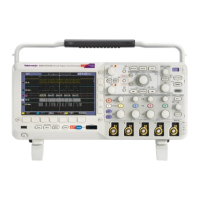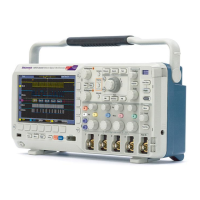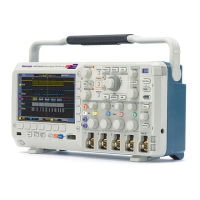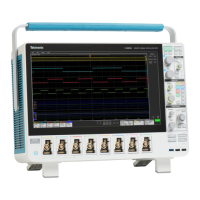Display Wavefor
mData
8. Select Fine Scale to enable multipurpose
knob a to make fine vertical scale
adjustments.
Fine Scale
9. Select Offset to enable multipurpose knob a
to make verti
cal offset adjustments.
On the side-bezel menu, choose Set to 0 V
to set the vertical offset to 0 V.
For more inf
ormation on offset, see Quick
Tips. (See page 83, Quick Tips.)
Offset
Position
10. Select Deskew to set the time skew
correction for the channel. Turn
multipur
pose knob a to adjust the time
skew (deskew) correction for the probe
attached to the selected channel. This shifts
acquisit
ion and display of the waveform left
or right, relative to the trigger time. Use
this to compensate for differences in cable
lengths
or probe types.
Deskew
Quick T
ips
Using Probes with the TekProbe II and TekVPI Interfaces. When you attach a probe with the TekProbe II or the
TekVPI interface, the oscilloscope sets the channel sensitivity, coupling, and termination resistance automatically to
match the probe requirements. Tek Probe II probes require use of the TPA-BNC Adapter. TekVPI probes require the use
of a 119‑7465‑XX external power supply.
The Difference Between Vertical Position and Offset. Vertical position is a display function. Adjust the vertical
position to place the waveforms where you want to see them. The waveform baseline locations track adjustments
made to their positions.
When you adjust vertical offset, you see a similar effect, but it is actually quite different. Vertical offset is applied before
the oscilloscope preamplifier and can be used to increase the effective dynamic range of the inputs. For e xample, you
can use vertical offset to look at small variations in a large DC voltage. Set the vertical offset to m atch the nominal DC
voltage and the signal appears in the center of the s creen.
MSO2000B and DPO2000B Series Oscilloscopes User Manual 83

